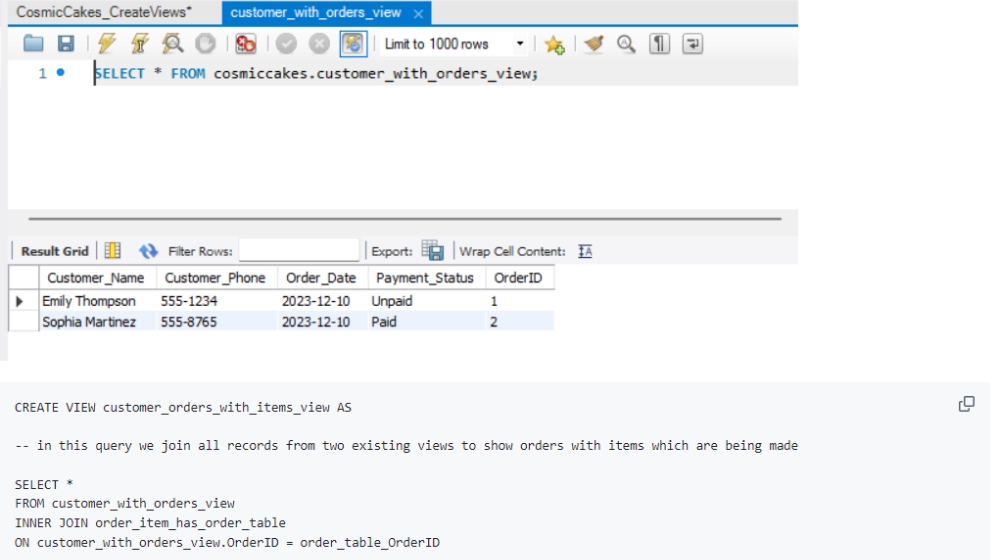Chris Coles (Tech)

Design Process Using MySQL Workbench: Cosmic Cakes
COMP 251: Introduction to Database Systems explores ways in which data collections are organized, stored, analyzed, and manipulated. Topics include relational databases, the SQL query language, and the basics of XML and web interfaces to data sets.
As a former student in COMP 251, Chris Coles (Introduction to Data Science Certificate ‘24) takes note of the course’s structure, which demands significant independent study. The course required Chris to deeply engage with the material, practicing and applying concepts until they were fully understood. He likens this process to experiential learning that is critical in technical fields. Just as a programmer spends countless hours debugging code, Chris had to spend considerable time refining his understanding of database design principles, often learning through trial and error.
“If you have any experience talking to programmers and others, a huge amount of their time is invested in essentially correcting errors throughout their work. This is no different. Anyone taking this course has really got to be prepared to put in a lot of time to get the kind of results they'd be happy with. Take what you've learned. Go and experiment with it. See what results you get, and then publish that.”
His project, the design of a database for a fictional bakery called "Cosmic Cakes," was a practical application of the skills he was developing. Chris chose this project because it provided a manageable yet rich scenario for exploring database design. The bakery, with its need to manage orders, inventory, customer data, and production details, offered a microcosm of the challenges faced by small businesses. Using MySQL Workbench, Chris was able to create a database that not only stored information efficiently but also maintained the necessary relationships between different data sets—ensuring that information was organized, accessible, and logically connected.

“It was something easy to conceptualize: a bakery that takes orders and produces things, and then serves the customer. That provides a little bit of configuration and variability. What does that mean? What kind of relationships would there be between the customers, the bakers, the chefs, and then articulate that into a piece of software that helps manage some of that. It was based on taking orders which could be configured slightly. If you wanted a chocolate cake, if it was going to be a round cake, a square cake or a tiered cake, so on.”
The project taught him key principles of database design, particularly the importance of understanding relationships between data entities and the need for rationalization to avoid redundancy and maintain data integrity. Chris found MySQL Workbench to be a user-friendly tool, offering both the flexibility to write code and the convenience of a visual interface for designing databases. This dual approach allowed him to experiment with different methods of creating and managing the database, reinforcing his learning through both coding and visual representation.
Chris’ professional background in freight forwarding, where he manages complex logistics for global projects, has always required a level of problem-solving and adaptability. His work involves coordinating the movement of goods across various modes of transportation—road, rail, ocean—often within the context of large-scale projects like construction or energy development. Each project comes with its own unique demands, and Chris has often has to develop or adapt systems on the fly to meet these challenges. The skills he acquired in his course are directly applicable to his work, particularly in terms of designing and implementing systems that can handle complex, project-specific data.
“What I found in my career over the years is that in a lot of cases when we arrive at these projects, even though our scope is somewhat aligned to what we do, each project has its own unique demands or peculiarities. Our systems are either too rigid or too slow to be able to make the changes or create new systems to deal with what the project has. In a lot of cases, we fill bits of this with constructed solutions that we put together. Sometimes that's on the reporting side and sometimes that's on the database side just to manage certain tasks or information. This project was just a nice way to do more of that and get more up to speed with certain bits of software.”
Looking forward, Chris is not just focused on immediate career benefits. He sees this course as part of a broader strategy to equip himself with new skills that will keep him engaged and creative as he approaches retirement. He recognizes that the future of work, even in his field, is increasingly tied to data and technology, and he wants to be prepared to continue contributing meaningfully, whether in his current role or in new endeavors after retirement.
For Chris, the course was more than just an educational experience—it was a strategic investment in his future. He appreciates the opportunity to gain a solid understanding of the tools and methods used by professionals in fields increasingly driven by data. This understanding not only bolstered his appreciation for the work done by experts in these areas but also gave him the confidence to tackle similar challenges in his own career.
